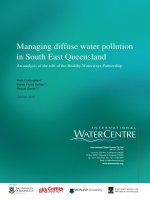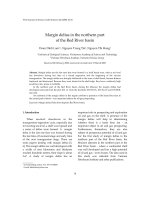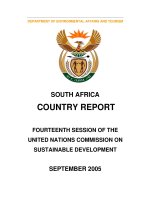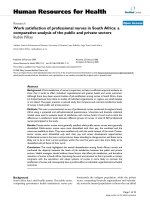Petroleum Geology of the South Caspian Basin
Bạn đang xem bản rút gọn của tài liệu. Xem và tải ngay bản đầy đủ của tài liệu tại đây (9.27 MB, 464 trang )
Petroleum Geology
of the
South Caspian Basin
ii Contents
Petroleum Geology
of the
South Caspian Basin
Leonid A. Buryakovsky
George V. Chilingar
Fred Aminzadeh
Boston Oxford Johannesburg Melbourne New Delhi Singapore
Gulf Professional Publishing is an imprint of Butterworth–Heinemann.
Copyright © 2001 by Butterworth–Heinemann
A member of the Reed Elsevier group
All rights reserved.
No part of this publication may be reproduced, stored in a retrieval system, or transmitted in
any form or by any means, electronic, mechanical, photocopying, recording, or otherwise,
without the prior written permission of the publisher.
Recognizing the importance of preserving what has been written, Butterworth–Heinemann
prints its books on acid-free paper whenever possible.
Butterworth–Heinemann supports the efforts of American Forests and the
Global ReLeaf program in its campaign for the betterment of trees, forests,
and our environment.
Library of Congress Cataloging-in-Publication Data
ISBN 0-88415-342-8
British Library Cataloguing-in-Publication Data
A catalogue record for this book is available from the British Library.
The publisher offers special discounts on bulk orders of this book.
For information, please contact:
Manager of Special Sales
Butterworth–Heinemann
225 Wildwood Avenue
Woburn, MA 01801-2041
Tel: 781-904-2500
Fax: 781-904-2620
For information on all Gulf Professional Publishing publications available, contact our
World Wide Web home page at: .
10 9 8 7 6 5 4 3 2 1
Printed in the United States of America
Contents v
Dedication
This book is dedicated to His Highness, the Amir of Kuwait,
Sheikh Jaber Al Ahmed Al Sabah, for His outstanding support
of the petroleum industry and personal concern He has demon-
strated for the well being of His people.
vi Contents
Special Acknowledgment
We especially wish to acknowledge the outstanding help
of academician John O. Robertson Jr., Ph.D., in prepara-
tion of the illustrations. The help extended by Michael V.
Garfunkel, Essam Al-Ajeel, and Khaled Ben-Ameirah is also
greatly appreciated.
CHAPTER 1
CH
Contribution No. 10, Rudolf W. Gunnerman
Energy and Environment Laboratory,
University of Southern California, Los Angeles, California
Contents vii
Contents
Foreword, x
Preface, xii
Nomenclature, xv
Abbreviations, xix
Structures of Azerbajan Part of the South Caspian Basin, xx
CHAPTER 1
Geology of Azerbaijan and the
South Caspian Basin 111
General Overview, 1. Geologic Setting of Super-Deep
Deposits, 5. Saatly Super Deep Well, SD-1, 9.
CHAPTER 2
Mud Volcanoes 116
Yasamaly Valley, 18. Alyaty Ridge, 20.
CHAPTER 3
Regional Distribution of Oil and Gas 122
CHAPTER 4
Lithostratigraphic Framework 127
vii
CHAPTER 5
Onshore Oil and Gas Fields 132
Region I: Apsheron Peninsula, 32. Region II:
Pre-Caspian–Kuba Monocline, 43. Region III: Lower
Kura Lowland, 44. Region IV: Yevlakh-Agdzhabedi Area, 44.
CHAPTER 6
Offshore Oil and Gas Fields 52
Caspian Sea Overview, 52. Zone I: Western Portion
of Apsheron–Pre-Balkhan Anticlinal Trend, 57. Zone II:
South Apsheron Offshore Area, 91. Zone III: Baku
Archipelago, 101.
CHAPTER 7
General Regularities in Oil and
Gas Distribution 113
I. Azerbaijan Portion of the South Caspian Basin, 113.
II. Turkmenistan Portion of the South Caspian Basin, 199.
III. Regions Adjacent to the South Caspian Basin, 212.
CHAPTER 8
Conclusions (Chapters 1–7) 239
CHAPTER 9
Mathematical Models in Petroleum Geology 243
Introduction, 243. Mathematical Simulation of Geologic
Systems, 244.
CHAPTER 10
Mathematical Models in Oil and Gas Exploration
and Production (Static Geologic Systems) 248
Mapping of Structures within the Apsheron–Pre-Balkhan
Anticline Trend, 248. Reservoir Characterization Using
viii
Log Data, 254. Modeling of Sedimentary Sequences Based
on Well-Logging Data, 284. Entropy as Criterion of
Heterogeneity of Rocks, 290. Anisotropy of Stratified Rocks,
297. Permeability of Reservoir Rocks, 302. Surface Activity of
Rocks, 313. Models of Oil Composition and Properties, 324.
CHAPTER 11
Mathematical Modeling of Geological Processes
(Dynamic Geological Systems) 347
Methodology of Simulation of Dynamic Systems, 347.
Mathematical Simulation of Sediment Compaction, 355.
Numerical Simulation of Oil- and Gas-Bearing Rock
Properties, 365.
CHAPTER 12
Other Applications of Numerical Simulation
Methodology 384
Basic Principles and Calculation Techniques, 384.
Simulation of Reservoir-Rock Properties, 386. Simulation
of Petrophysical Properties of Rocks, 390. Simulation of
Water Invasion into Oil-Saturated Rocks, 398. Simulation
of Pore-Fluid (Formation) Pressure, 400. Simulation of
Hydrocarbon Resources and Evaluation of Oil and Gas
Reserves, 403.
CHAPTER 13
Conclusions (Chapters 8–13) 408
Bibliography 410
CHAPTER 1
VH
ix
Foreword
If the end of cold war is the biggest news of the century in terms of
world politics, the unleashing of the wealth in terms of untapped oil and
gas reservoirs in the Caspian Sea region is probably the biggest economic
news of the same century. Addressing the petroleum geology of South
Caspian Basin at this crucial time of energy awareness shows unparalleled
wisdom, experience, and maturity of the authors. The timing for such a
useful book on a region that is considered to be the next Persian Gulf
could not be more appropriate.
The news of petroleum discoveries in the Caspian Sea region continue
to pour in. Only a few months ago, the news broke about the possibility
of discovering 50 billion barrel in the Kashagan offshore structure. If this
is true, as all indications are, this latest discovery will put Kashagan
structure second to only Saudi Arabia’s onshore Ghawar field, with
remaining reserve of 70 billion barrels. Incidentally, Saudi offshore,
Safaniya, the world’s currently known largest offshore deposit contains
19 billion barrels. The book provides one with a treasure of information
on the most studied section of the Caspian Sea region. The book is written
with a comprehensive approach that includes the development of scientific
bases, simulation techniques, and mathematical models of both static and
dynamic geological systems. This approach is necessary if one is interested
in exploration, development, and production of a petroleum reservoir. The
combination of science and engineering has been sought for a long time,
and the book provides one with a fine example of how one should
approach in developing oil and gas fields in the 21st century.
As the world order is moving from the Modern to the Knowledge Era,
the petroleum industry is creating a culture that requires combining cutting
edge science with engineering into the core of decision making structure.
This, in petroleum vocabulary, means that the petroleum industry must
combine geological and geophysical skills with petroleum production
engineering. This book collects this information from the anal of 150 years
x
of exploration and production history of the Caspian Sea region and
presents them in a format that is useful for both scientists and engineers.
The book is helpful for determining oil and gas potential as well as
optimum production strategies in the region.
The book takes the reader through some of the most fundamental
description of geological history in the region, and embarks into the
application of advanced mathematical models and engineering techniques.
The authors do this with impeccable dexterity and provides the reader with
a powerful interdisciplinary tool for exploration, reserve evaluation, and
production optimization. The authors take a bold approach to educating
engineers on some of the essential aspects of geology and geophysics. I
am not aware of another book that amalgamates geology, geophysics, and
petroleum engineering with such a seamless approach. I recommend this
book to every geologist, geophysicists, practicing engineer, graduate
student, and academic who is engaged in petroleum studies.
Rafiq Islam
Killam Chair in Oil and Gas
Dalhousie University
Canada
xi
Preface
The Caspian Sea is a highly promising oil- and gas-bearing province,
because prolific oil and natural gas regions situated in the territories
of Russia, Kazakhstan, Azerbaijan, and Turkmenistan extend to the
Caspian Sea area (Figure 1-1). The Caspian Sea is the world’s largest
salt lake—its length from the north to south is 1,174 km/730 mi.,
average width is 326 km/203 mi, and total area is 375,000 km
2
/
145,000 mi
2
. Water depth in the middle of the sea ranges up to
788 m/2,584 ft and in the southern part, up to 1,025 m/3,361 ft.
The Caspian Sea has no outlet, and although the surface level fluc-
tuates, it averages about 25 m/82 ft below ocean level according to
recent measurements.
Geological studies in the Caspian Sea began in the second half of
the 19th century. The South Caspian Basin, which comprises the South
Caspian Sea, Eastern Azerbaijan, and Western Turkmenistan, with a
high density of confirmed structures, was studied in greatest detail.
Hydrocarbon accumulations have been discovered, explored and produced
in areas with water depth up to 60 m/200 ft, and several oil and gas
fields have been discovered in water depth up to 200 m/655 ft.
Azerbaijan is one of the independent countries in western Asia,
bounded on the south by Iran (Province of Iranian Azerbaijan), on the
north by Russia, on the west by Georgia and Armenia, and on the east
by the Caspian Sea. The country consists mainly of lowlands sur-
rounded by the Kura River and its tributary, the Araks, which forms
the border with Iranian Azerbaijan. The landscape ranges from semi-
desert to mountains of the Greater and Lesser Caucasus. Azerbaijan
covers an area of about 86,600 km
2
or 33,400 mi
2
.
Azerbaijan is one of the oldest oil- and gas-producing provinces in
the world. For example, the oldest oil-field, the Kirmaku, has been
known from ancient times as a place of primitive production of oil
xii
and asphalt. The earliest date of Kirmaku field production is about
1834. The first deep oil well in Azerbaijan was drilled in the Bibieibat
oilfield in 1848.
Recoverable reserves of this unique oil- and gas-bearing province
include about 1,700 MMtons/12 Bbbl of oil and 1 Tm
3
/35 Tft
3
of
natural gas. The main oil- and gas-bearing section in Azerbaijan is the
so-called clastic Productive Series of Middle Pliocene age. It includes
about 90% of all the identified hydrocarbon reserves of Azerbaijan and
adjacent offshore area of the South Caspian Basin. During the last 20
years, a new type of reservoir rocks has been discovered in the
territory of central and western Azerbaijan, mainly in the central
portion of the Kura Depression. Commercial oil and gas reserves are
present in the fractured Upper Cretaceous volcanic rocks.
Extensive offshore development in Azerbaijan began in 1949. Since
then, numerous oil and natural gas fields have produced about half
their recoverable reserves. All fields are multi-bedded with as many
as 30 producing zones in the Middle Pliocene sandstones and silt-
stones. Exploratory and production drilling is carried out from indi-
vidual platforms and piers. Also, floating and semi-submersible drilling
rigs are used for exploration. At present, exploration drilling in the
Caspian Sea is carried out in water depth of 200 m/655 ft; the deepest
well was drilled to a depth of 6,500 m/21,311 ft. Azerbaijan’s Apsheron
Peninsula and adjacent offshore area is now being developed under
multi-billion dollar contract with Western oil companies.
Turkmenistan is located in Central Asia and is the southernmost of
the CIS countries. The Turkmenistan Republic is bordered by the
Caspian Sea to the west, Iran and Afghanistan to the south, Kazakhstan
to the north, and Uzbekistan to the northeast and east. Its territory
extends 1,100 km east-west and 650 km north-south and covers an
area of approximately 488,000 km
2
or 188,200 mi
2
. The climate of
the country is dry and 80% of its territory is desert. Water resources
are distributed by canal and irrigation systems. The petroliferous areas
include the eastern portion of South Caspian Basin and the Amu-Darya
oil- and gas-bearing provinces.
The presence of seeps and mud volcanoes first attracted attention
to the eastern part of South Caspian Basin at an early date. Oil was
being produced from 3500 hand-dug wells and seeps on Cheleken
Island by 1938. About 28 fields have been discovered to date in
western Turkmenistan (onshore and offshore). More than 48 fields have
xiii
been discovered since the beginning of petroleum exploration in the
Amu-Darya area in 1929.
After Russia, Turkmenistan is the second largest gas-producing
republic. In 1990, the gas production was 3,100 Bft
3
. Oil production
decreased 30% after 1980, but was stable (50 Mbbl/yr) during the last
five years of 1980s.
In Western Turkmenistan, the most promising area is probably the
shallow offshore. With water depths of 50 m/164 ft or less, exploration
and production techniques developed in the Gulf Coast area of U.S.
could be applied here, i.e., using drilling barges and dredges in very
shallow water and jack-up rigs in deeper water.
Progress in the oil- and gas-producing industry is related closely to
the improvement in exploration techniques and increase in discovery
rates. Exploration and production of hydrocarbon resources must be
based on reliable scientific information. During more than 150 years
of oil and natural gas exploration and production in Azerbaijan, a great
amount of geological, geophysical, petrophysical, geochemical, and
engineering information has been gathered. This information will aid
in estimating oil and gas reserves as well as improving field develop-
ment technology. We used advanced mathematical methods to process
the geological, geophysical, and engineering data, and our investigation
included development of simulation techniques and construction of
mathematical models of both static and dynamic geologic systems
(geologic processes).
Leonid A. Buryakovsky
George V. Chilingar
Fred Aminzadeh
xiv
Nomenclature
A area
A
da
diffusion-adsorption factor
A
t
absolute geological age
B “benzine” (gasoline) content
C
carb
carbonate cement content
C
cl
clay cement content
C
sh
shale cement content
D depth
d diameter
d
w
wellbore diameter
d
act
actual wellbore diameter
d
nom
nominal wellbore diameter
d
ch
pore-channel diameter
d
p,ave
average pore diameter
d
p,Me
median pore diameter
F formation resistivity factor
F
p,t
formation resistivity factor at reservoir conditions
F’ resistivity index
F’
p,t
resistivity index at reservoir conditions
G geothermal gradient
∆G Gibbs free-energy difference
H entropy of information
H
max
maximum entropy
H
r
relative entropy
H
o
zero hypothesis
h thickness
h
eff
effective (net) thickness
h
sh
shale thickness
I quantity of information
∆I
γ
relative GR factor
∆I
nγ
relative NGR factor
xv
K filtration coefficient
K
a
pressure-abnormality factor
k permeability
k
||
permeability parallel to bedding
k
⊥
permeability perpendicular to bedding
k
i
modeling coefficient
L ligroin content
L length
L
c
length of capillaries
M mathematical expectancy
m number of parameters in the data matrix
m cementation exponent
N number of measurements, tests or observations
n number of objects in the data matrix
n saturation exponent
p
i
probability
p pressure
p
e
external pressure, total overburden pressure
p
i
internal pressure, pore-fluid pressure
p
eff
effective (grain-to-grain) pressure
p
p
pore pressure
p
r
reservoir pressure
∆p differential pressure
Q
100
cation-exchange capacity per 100 g of rock
q volumetric flowrate
q
liq
liquid production rate
q
oil
oil production rate
R resins plus asphaltenes content
R
d
rate of sedimentation
R electric resistivity
R
a
apparent resistivity
R
a
(AO)apparent resistivity from lateral sonde of AO size
R
cr
oil-saturated reservoir rock cut-off (critical) resistivity
R
g,r
gas-saturated reservoir rock resistivity
R
oil
oil resistivity
R
o,r
oil-saturated reservoir rock resistivity
R
sh
shale resistivity
R
t
true resistivity
R
t,min
minimum true resistivity
xvi
R
w
water resistivity
R
o
water-saturated reservoir rock resistivity
R
m
drilling-mud resistivity
R
mf
mud-filtrate resistivity
R
IL
resistivity from Induction Log
r correlation coefficient
r radius
r
c
radius of capillaries
S
o
oil saturation
S
o/g
oil/gas saturation
S
o,r
residual oil saturation
S
w
water saturation
S
w,r
residual water saturation
S
carb
homogeneity of carbonates
S
sort
sorting factor
S
sh
sorting of shales
S
ss
sorting of sandstones
s
b
specific surface area of pore space per unit of bulk volume
s
g
specific surface area of pore space per unit of grain volume
s
p
specific surface area of pore space per unit of pore volume
s
hf
shape factor for pores
T temperature
∆t interval transit time
t time
t
α
probability index @ α confidence level
U relative change in volume of sediments
∆U
SP
relative SP factor
V volume
V
c
volume of capillaries
V
s
seismic velocity
v
λ
variation of anisotropy
v
R
variation of resistivity
α probability error or confidence level
α
SP
SP reduction factor
β modulus of elasticity
β
c
irreversible compaction factor (compressibility factor)
γ density
η relative clay content in rock
η
p
pore-pressure gradient
xvii
η
sh
pore-pressure gradient in shales
η
r
formation-pressure gradient in reservoir rocks
λ anisotropy coefficient
µ dynamic viscosity
ν kinematic viscosity
σ stress
σ standard deviation, or mean square error
σ
R
standard deviation of resistivity
σ
r
standard deviation of correlation coefficient
τ electrical tortuosity of pore channels
τ
w
thickness of pore-water film
φ porosity
φ
′
“residual” porosity
φ
eff
effective porosity
φ
sh
shale porosity
χ
sh
relative content of shales
ω frequency or probability
Σω cumulative frequency or probability
Σ macroscopic cross-section of thermal neutron capture (absorption)
xviii
Abbreviations
AHFP abnormally high formation pressure
bbl barrels
Bbbl billion barrels of oil
Bcfg billion cubic feet of gas
bpd barrels per day
bopd barrels of oil per day
cfd cubic feet per day
cmd cubic meters per day
FSU Former Soviet Union
GKZ State Committee on Reserves (in FSU)
GOC gas-oil contact
GOR gas/oil ratio
GWC gas-water contact
HC hydrocarbons
Mbpd thousand barrels per day
Mcfd thousand cubic feet per day
Mcmd thousand cubic meters per day
MD measured depth
MMcfd million cubic feet per day
MMcmd million cubic meters per day
MMt million tons
MSE mean square error
Mtd thousand tons per day
OWC oil-water contact
PTD proposed total depth
SEM scanning electron microscope
Tcf trillion cubic feet
Tcfg trillion cubic feet of gas
tpd tons per day
TD total depth
TOC total organic carbon
TVD true vertical depth
xix
Structures of
Azerbaijan Part of the
South Caspian Basin
After declaring independence in 1991, many structures, oil and gas
fields, and prospects in Azerbaijan were renamed. For reference, a list
of old and new names of most oil and gas fields and prospects located
in the Azerbaijan part of the South Caspian Basin is provided below.
In this book, only new names are used.
Old names: New names:
26th Baku Commissars Azeri
28th of April Gyuneshli
40th Anniversary of Azerbaijan Ashrafi
Abramovich Karabakh
Aliyev Guba Deniz
Andreyev Bank Umid
Andriyevski Bank Gilavar
East Andriyevski Bank Khazri
Artyom Island Pirallaghi Adasi
Arzu Arzu
Asadov Zirva
Bakhar Bakhar
Borisov Bank Inam
Bulla Island Khara Zyrya
Bulla-moré Bulla Deniz
Byandovan-moré Byandovan Deniz
Darvin Bank Darvin Bank
Duvanny Island Zenbil
xx
Old names: New names:
East Apsheron Shargi Absheron
Galyaba Galyaba
Golovachev Bank Atashkyakh
Gryazevaya Sopka Palchygh Pilpilasi
Gyandzhlik Gyandzhlik
Gyurgyany-moré Gyurgyan Deniz
Kalmychkov Bank Shirvan Deniz
Kamen’ Ignatiya Dashli
Kamen’ Persiyanina Aran Deniz
Kamni Dva Brata Goshadash
Kamni Grigorenko Khali
Karadag-moré Karadag Deniz
Karagedov Bank Mugan Deniz
Kaverochkin Chyragh
Khamamdag-moré Khamamdag Deniz
Kornilov-Pavlov Bank Sabail
Kumani Bank Chigil Deniz
Kurinskiy Kamen’—1 Kyurdashi
Kurinskiy Kamen’—2 Araz Deniz
Kyurdakhany-moré Kyurdakhany Deniz
Kyzylburun-moré Kyzylburun Deniz
Lenkoran’-moré Lenkoran Deniz
Maiskaya Airapa
Mekhdi Gusein-zadeh Ufug
Midiya Midiya
Nakhichevanskiy Nakhchevani
Nardaran-moré Nardaran Deniz
Neftechala-moré Neftechala Deniz
Neftyanyye Kamni Neft Dashlary
Neftyanyye Kamni—2 Oguz
North Apsheron Shimali Absheron
Peschany Island Gum Adasi
Peschany-moré Gum Deniz
Pogorelaya Plita Yanan Tava
Promezhutochnaya Kyapaz
Putkaradze Saba
Samedov Seiyar
xxi
Old names: New names:
Samed Vurgun Vurgun
Sangachaly-Duvanny-Bulla Sangachal-Duvanny Deniz-Khara
Island Zyrya
Sangi Mugan’ Sangi Mugan
Sevindzh Sevindzh
Shakhovo-moré Shakh Deniz
Shapirovskiy Danulduzu
South Kurinskaya Talysh Deniz
South Shirvanskaya Lerik Deniz
Sovetabad-moré Shorabad Deniz
Topkhana Sumgait Deniz
Tsyurupa Bank Agburun Deniz
Tyurkyany-moré Tyurkyan Deniz
Uzeir Gadzhibayev Peik
West Apsheron Garbi Absheron
Yakubov Khamdem
Yalama Khudat Shollar Deniz
Yashma-moré Yashma Deniz
Yuzhnaya Dzhanub
Yuzhnaya—2 Dzhanub—2
Zhiloi Island Chalov Adasi
Zorat-moré Dzhorat Deniz
xxii
1
CHAPTER 1
Geology of
Azerbaijan and the
South Caspian Basin
GENERAL OVERVIEW
The territory of Azerbaijan (Figure 1-1) is part of the Alpine fold
belt and consists of folded systems, embracing the eastern parts of
the Greater and Lesser Caucasus Mountains, the Kura Intermontane
Depression (Kura Lowland) separating them, and also the Middle and
South Caspian basins (Figure 1-2). Thickness of the Earth’s crust here
ranges from 38 to 55 km. The greater thickness occurs within the
Greater Caucasus, the lesser in the Talysh foothills. In the submontane
belt of the Lesser Caucasus crustal thickness reaches 40 to 45 km, and
50 km in the Kura Intermontane Depression.
Peculiarities of the folded system of the Greater Caucasus include
a flysch-filled trough at the southern slope of the Greater Caucasus
with an extensive development of overlying structures. Where isolated,
Early Jurassic, shaly copper-pyrite deposits occur. Within the Kura Inter-
montane Depression, Mesozoic-Early Paleogene and Late Paleogene-
Quaternary structures are clearly distinguished. The first stage of
Mesozoic volcanogenic-sedimentary rocks forms a single unit within
the folded system of the Lesser Caucasus in the south and the Vandam
zone in the north. Within the depression, a thick sequence of Late
Paleogene-Quaternary deposits is widespread, unconformably overlying
the lower structures. The Lesser Caucasus was a zone of volcanism
during the Mesozoic, Paleogene, Miocene-Pliocene and Quaternary,
and is characterized, in the central part, by an extensive ophiolitic
belt—the eastern portion of the North Anatolia Belt.
2 Petroleum Geology of the South Caspian Basin
Jurassic and Cretaceous deposits are widespread in Azerbaijan.
Lower Jurassic deposits (thickness of 2,000 m and more) are widely
distributed in the Greater Caucasus and are represented by slate and
sometimes by sandstone, with intrusive sheets of diabase and gabbro-
diabase. In its analogous terrigenous facies, the Lower Jurassic is more
sparsely represented in the Lesser Caucasus and the Nakhichevan
region. Apparently, within the Kura Depression, the Lower Jurassic
deposits occur as equivalent, thin terrigenous facies.
The lowermost Middle Jurassic strata of the Greater Caucasus are
composed of argillaceous slates with rare partings of sandstone,
Figure 1-1. Caspian Sea Region
(Modified after National Geographic Society
map, Washington, D.C., 1999).
Geology of Azerbaijan and the South Caspian Basin 3
whereas the uppermost section (2,500 to 4,000 m thick) is dominated
by thick strata and beds of quartz sandstones with rare partings of
shales. In the Lesser Caucasus, terrigenous rocks (thickness of 120 m)
of the lowermost Middle Jurassic [the main part of the section (2,000–
3,000 m thick)] consists of lava sheets and diabasic volcanics. Quartz
plagio-porphyrites with their volcaniclastic and sedimentary-volcanogenic
sequences occur in the uppermost strata. In the Kura Depression these
deposits are represented by similar facies.
The Upper Jurassic deposits in the northern slope of the Greater
Caucasus are composed of calcarenites and reef limestones (thickness
Figure 1-2. Structural pattern of Azerbaijan
(Modified after the Excursion
Guide-Book for Azerbaijan SSR, Vol. II, 1984)
. A—Greater Caucasus Anti-
clinorium; B—Kura Intermontane Depression; C—Lesser Caucasus Anti-
clinorium; D—South Caspian Basin; I—Gobustan-Apsheron Trough; II—Lower
Kura Trough; III—Geokchai-Saatly Anticlinal Trend; IV—Yevlakh-Agdzhabedy
Trough; V—Iori-Adzhinour Trough. 1—Quaternary, 2—Miocene–Paleogene,
3—Mesozoic, and 4—consolidated crust.









